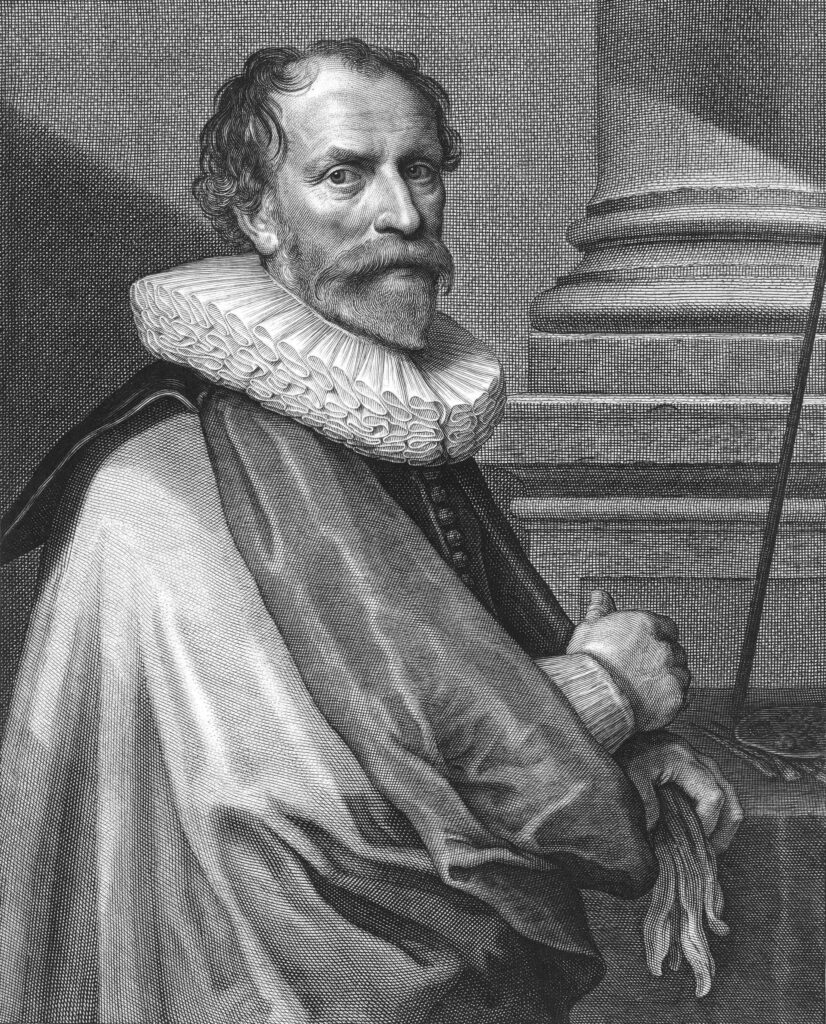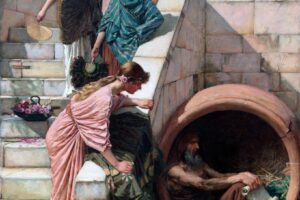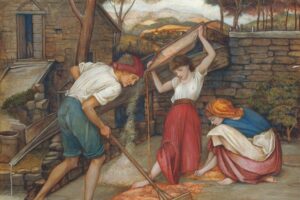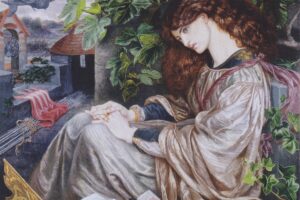Portrait of a Gentleman – Portrait of a Lady
Michiel Jansz. van Mierevelt, 1609 – Baroque
In the year 1609, Dutch portraitist Michiel Jansz. van Mierevelt captured a couple seated in stillness, yet surrounded by the silent eloquence of wealth, order, and devotion. These paired portraits—painted during the flourishing early Baroque era in the Dutch Republic—are more than mere likenesses. They are declarations of status, dignity, and legacy. Each sitter holds their pose with quiet pride, dressed not for comfort, but for permanence.
The Scene Before Us
We see two separate canvases, but their subjects belong to the same world, and likely the same household. On the left, the gentleman stands upright in fine black attire, his hand confidently resting on his hip, trimmed lace cuffs radiating against the dark velvet. On the right, the lady is seated with equal poise, her intricate gold embroidery and wide lace collar forming a perfect frame of symmetry and control. The green drapery behind them adds a vivid counterpoint to their monochrome finery.
The Deeper Meaning
In the Dutch Golden Age, portraits were not simply about the individual—they were a social performance. These paintings reveal not just who the couple were, but what they believed in: piety, modesty, order, and prosperity. Their clothing speaks volumes. Black was costly to dye and reserved for the affluent, while lace and embroidery signaled refinement and restraint. Each detail is painted with precision, not just to flatter, but to endure.
A Moment Caught in Time
Van Mierevelt’s precision gives these figures a stillness that almost feels eternal. Yet, beneath the rigidity, there is warmth: a glint in the eye, a soft fold in the hand. These portraits remind us that dignity can be both firm and tender, that love can exist even in silence. Though they do not touch or gaze at one another, their shared backdrop and visual harmony speak of a life lived in unity. They were once living, breathing people—but now, they remain as they wished to be remembered: composed, complete, and side by side.
About Artist

Michiel Jansz. van Mierevelt (1567–1641) was a highly influential Dutch painter of the Baroque period, but one who is primarily known for his contribution to portraiture rather than the dramatic religious and mythological scenes often associated with the style. He was one of the most successful and prolific artists of the Dutch Golden Age, and his studio in Delft became a portrait factory, producing thousands of likenesses for a wealthy and discerning clientele
The Official Court Painter
Van Mierevelt’s career was a testament to his commercial success. He was appointed court painter to the House of Orange-Nassau in 1607, a position that solidified his status as the premier portraitist of his time. His patrons included not only the Dutch nobility but also foreign diplomats and the affluent burgher class, all seeking his elegant and sober style.
His portraits are characterized by a precise, almost meticulous realism. He focused on capturing the sitter’s character with sincerity and a restrained composition. He favored a simple, dark background that contrasted sharply with the sitter’s pale face and intricate clothing, particularly the elaborate ruffs and lace collars that were the height of fashion.
Notable Works
Van Mierevelt’s extensive oeuvre is dominated by portraits, which were often reproduced by his studio assistants to meet the high demand. While many works bear his name, only a portion are entirely by his hand. Among his most well-known paintings are the portraits of the princes of the House of Orange, including Maurits and Frederick Henry.
A prime example of his work and a common format for his portraits are the twin paintings, “Portrait of a Gentleman” and “Portrait of a Lady”, from around 1620. These pendants, now in separate collections, exemplify his signature style:
- Portrait of a Gentleman: Depicts a man in a black doublet and a meticulously rendered white ruff. His dignified pose and calm expression are characteristic of Van Mierevelt’s approach to male portraiture.
- Portrait of a Lady: The companion piece shows a woman in an equally elegant black dress and lace collar. Her posture is a mirror image of the gentleman’s, creating a harmonious pair.
These twin portraits illustrate how Van Mierevelt mastered the art of conveying wealth, status, and individual character through subtle details of costume, expression, and light. He was a master of his craft, providing a sober and enduring record of the Dutch elite during the early 17th century.



